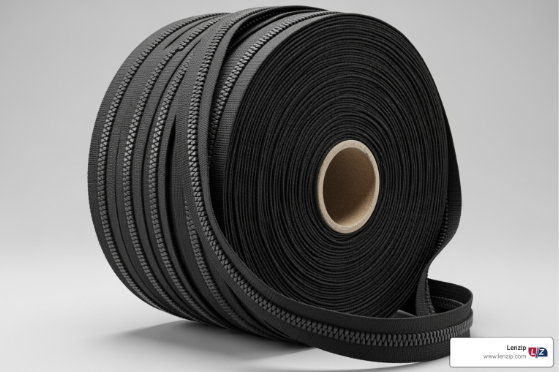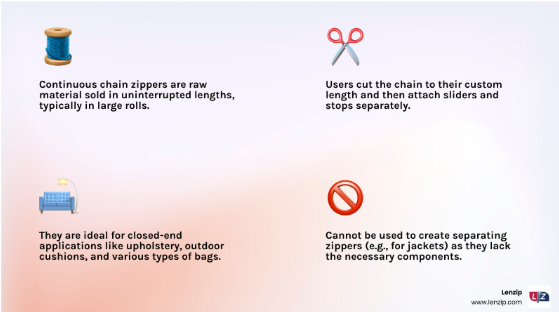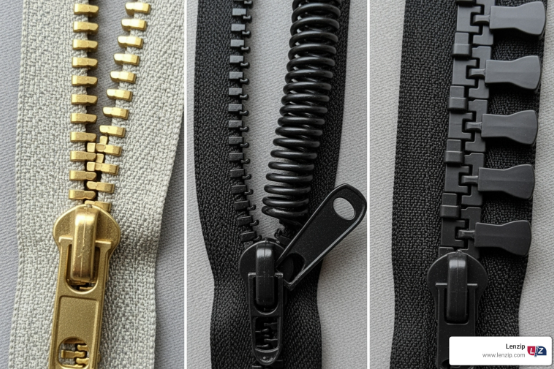Beyond the Basics:
A Guide to Continuous Chain and Specialty Zippers
Unzip the world of continuous chain zipper. Learn types, sizes, materials, and how to assemble custom industrial & specialty zippers.
All About Your Zipper’s Moving Pieces
A continuous chain zipper is a length of zipper chain sold by the yard without pre-attached sliders or stops, allowing you to cut it to any custom length needed for your project. This type of zipper gives manufacturers maximum flexibility for creating custom-sized fasteners.
Learn more about Zipper Types.
Quick Facts About Continuous Chain Zippers:
What it is: Raw zipper material sold in continuous lengths (typically 100-yard rolls)
How it works: You cut to desired length and attach sliders and stops separately (Zipper Parts & Sliders)
Best for: Closed-end applications like cushions, bags, and upholstery
Cannot make: Separating zippers (jackets, coats)
Available in: Multiple materials (nylon coil, metal, molded plastic) and sizes (#2 through #10) (Zipper Size Chart)
If you’ve ever struggled to find the exact zipper length you need, you’re not alone. Standard pre-made zippers come in limited sizes, often forcing you to compromise on your design or waste material. That’s where continuous chain zippers shine – they solve the custom length problem that frustrates so many manufacturers.
Zippers might seem simple, but choosing the wrong type can cost you time, money, and customer satisfaction. Whether you’re making marine covers that need to withstand saltwater, furniture that requires fire-retardant zippers, or precision aerospace components, understanding your fastener options is crucial.
This guide will walk you through everything you need to know about continuous chain zippers and other specialty zippers. We’ll cover materials, sizes, assembly techniques, and help you choose the right solution for your specific application.

What is a Continuous Chain Zipper?
Picture walking into a fabric store and buying ribbon by the yard. A continuous chain zipper works the same way – it’s zipper material sold in long, uncut lengths that you can customize to fit your exact needs.
Unlike the finished zippers on your jacket or bag, a continuous chain zipper comes as raw material. You’ll receive a roll of zipper tape with teeth attached, but no slider, no stops, and no predetermined length. It’s essentially “zipper by the yard” that gives you complete control over the final product.
This flexibility comes with one important limitation: continuous chain zippers work only for closed-end applications. Think cushion covers or bags where the zipper doesn’t need to separate completely. You can’t use this type of zipper chain to make separating zippers like those found on jackets.
The beauty lies in the customization. Need a 37-inch zipper for an oddly-shaped boat cushion? No problem. Want to make fifty 8.5-inch zippers for a production run? You’ve got it. The chain arrives in long rolls, typically 100 yards, ready for you to cut and assemble as needed.
Advantages of Using a Continuous Chain Zipper
The biggest advantage is unparalleled customization. You can cut the exact length you need, down to the millimeter. No more settling for a 20-inch zipper when you need 18.5 inches, or wasting money on a 36-inch zipper for a 24-inch application.
Cost-effectiveness becomes obvious when you’re working with longer zippers or unusual sizes. Buying a 100-yard roll and cutting what you need often costs significantly less than purchasing multiple pre-made zippers. Many suppliers offer bulk discounts for 10+ yards and 100+ yards, making large projects even more budget-friendly.
Reduced waste naturally follows. Since you cut only what you need, there’s minimal leftover material. This efficiency matters both for your budget and environmental impact.
The versatility extends beyond just length. Continuous chain zippers come in various materials, from lightweight nylon coil to heavy-duty metal, and in sizes ranging from delicate #2 to robust #10. This variety means you can adapt the same ordering process to projects ranging from delicate garments to rugged outdoor equipment.
Compare finishes and materials in Zipper Materials & Finishes.
Common Projects for Continuous Chain Zippers
Upholstery projects showcase continuous chain zippers at their best. Custom sofa cushions, throw pillows, and mattress covers often require specific lengths that standard zippers can’t accommodate. The seamless, perfectly-sized closures create a professional finish.
Outdoor cushions for patio furniture or boat seating benefit from both the custom sizing and material options. You can choose water-resistant materials and get the exact length needed for odd-shaped cushions.
Marine applications represent a major use case. Boat covers, bimini tops, and marine enclosures often require long, durable zippers that can withstand harsh conditions.
For more details about marine-specific solutions, visit our Marine Zippers.
Tents and sleeping bags often need zippers that run the entire length of an opening. A continuous chain zipper ensures a smooth, unbroken closure without weak points that can occur when joining multiple shorter zippers.
Luggage and bags benefit from design flexibility. Whether you’re making duffel bags, backpacks, or custom handbags, you can create compartments with precisely the right zipper lengths for both function and aesthetics.
Custom home decor projects extend beyond basic upholstery. Window seat cushions, floor pillows, and decorative covers often require unique zipper lengths that only continuous chain can provide. Even long bathrobes benefit from this customization capability.
Industrial applications often demand the longest zippers. Equipment covers, flexible ductwork, and specialized enclosures require durable closures that standard zippers simply can’t accommodate.
See more under Industrial Zippers.
A Guide to Zipper Types, Sizes, and Materials
Choosing the right zipper isn’t just about picking something that opens and closes. It’s about finding the perfect match for your project’s specific needs. The wrong choice can mean a zipper that fails under stress, looks out of place, or simply doesn’t perform in the conditions it faces.
Learn about zipper specs in Zipper Types.
Think of it like choosing shoes – you wouldn’t wear flip-flops to hike a mountain or steel-toed boots to the beach. The same principle applies to zippers. Let’s explore what makes each type unique.
Understanding Zipper Sizes: #3, #5, #10, and More
Those numbers you see on zippers – like #3, #5, or #10 – aren’t random. They tell you exactly how wide the zipper teeth are when the chain is closed, measured in millimeters. So a #5 continuous chain zipper has teeth that are about 5mm wide.
Here’s the simple rule: bigger numbers mean stronger zippers. It’s that straightforward.
Lightweight zippers (#2 and #3) are perfect when you want something subtle and flexible.
Medium-weight zippers (#4.5 and #5) are the workhorses of the zipper world.
Heavy-duty zippers (#7, #8, #9, and #10) are built for serious work.
The key is matching the size to your application. Using a tiny #3 zipper on a heavy canvas bag is asking for trouble, just like putting a massive #10 zipper on a delicate garment would look odd.
See the full Zipper Size Chart and Testing Standards.
Choosing the Right Material
The material of your continuous chain zipper determines how it behaves in the real world. Each type has its own personality and ideal applications.
Explore all finishes in Zipper Materials & Finishes.
| Material Type | Strength | Flexibility | Common Applications |
|---|---|---|---|
| Nylon Coil | Good. Resists tearing. | Excellent. Very flexible; can bend easily. | Apparel, luggage, bags, home décor, outdoor covers, curved seams. |
| Metal (Brass, Aluminum, Nickel) | Excellent. Very strong and durable. | Poor. Rigid; does not bend easily. | Jeans, heavy coats, leather goods, duffel bags, industrial uses. |
| Molded Plastic (VISLON®) | Very good; corrosion-resistant. | Good. More flexible than metal, but less than coil. | Outdoor gear, sportswear, marine gear, tents, cushions. |
Specialty Industrial Zippers
Sometimes standard zippers just won’t cut it. When your project faces extreme conditions, you need specialty zippers designed specifically for those challenges.
View all under Industrial Zippers.
Fire-retardant zippers are essential when safety is non-negotiable.
Water-resistant zippers feature coatings that repel moisture. Perfect for marine, outdoor, or protective gear.

How to Assemble Your Custom Zipper
Now that we understand what a continuous chain zipper is and the different types available, let’s get to the fun part: assembling our own custom zipper! It might seem daunting at first, but with the right tools and a step-by-step approach, you’ll be creating professional-quality zippers in no time.
Full tutorial: Zipper Assembly Guide.
Essential Tools and Components
Sharp scissors to cut the zipper tape to your desired length.
Pliers (needle-nose or chain-nose) to remove teeth and crimp stops.
Zipper jig — your secret weapon for smooth slider attachment.
Sliders and top/bottom stops that match your zipper size and type (Zipper Parts & Sliders).
Step-by-Step: From Chain to Finished Zipper
Measure and cut your chain.
Attach the zipper slider (use a jig if available).
Crimp bottom stop in place.
Add top stops on both sides.
Test movement and reinforce ends with stitching if needed.
And there you have it – you’ve just created a custom zipper from scratch!
Understanding Webbing Terminology can also help integrate zipper-webbing systems confidently.

Conclusion: Your Partner in Custom Zipper Solutions
We’ve taken quite a journey together through continuous chain zippers! From understanding what makes them special to learning how to assemble your own custom fasteners, you now have the knowledge to tackle projects that once seemed impossible.
The beauty of continuous chain zippers lies in their incredible versatility. Whether you’re creating marine covers, custom upholstery, or industrial equipment covers, these zippers give you the freedom to design without compromise.
At LenZip, we’ve been perfecting the art of zipper manufacturing for 80 years — all proudly made in the USA.
We’re more than a zipper supplier — we’re your OEM engineering partner.
Explore our full range:
Ready to start your next project? Request a Quote or reach Customer Support.
Need help understanding zipper terms? Visit our Zipper Terminology Guide.
Frequently Asked Questions about Zippers
Can I make a separating (open-end) zipper from a continuous chain?
No – continuous chain zippers are designed for closed-end applications only.
If you need an open-end zipper, order from Custom Zippers.
What’s the difference between locking and non-locking sliders?
Locking sliders stay in place until you lift the tab, while non-locking sliders glide freely.
Non-locking options are ideal for marine and industrial gear. (Zipper Parts & Sliders)
How do I know what size zipper I need?
Measure the width of the closed teeth in millimeters. #5 ≈ 5mm, #10 ≈ 10mm.
See the Zipper Gauge Guide.
